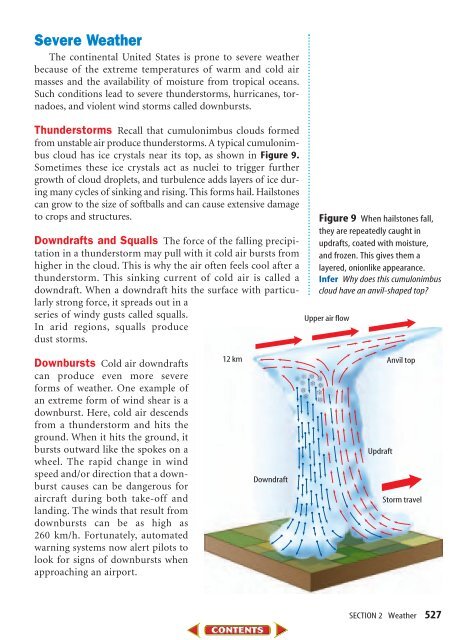CHAPTER 17 Weather and Climate - Mr. Barrow's Science Center
CHAPTER 17 Weather and Climate - Mr. Barrow's Science Center
CHAPTER 17 Weather and Climate - Mr. Barrow's Science Center
Create successful ePaper yourself
Turn your PDF publications into a flip-book with our unique Google optimized e-Paper software.
Severe <strong>Weather</strong>The continental United States is prone to severe weatherbecause of the extreme temperatures of warm <strong>and</strong> cold airmasses <strong>and</strong> the availability of moisture from tropical oceans.Such conditions lead to severe thunderstorms, hurricanes, tornadoes,<strong>and</strong> violent wind storms called downbursts.Thunderstorms Recall that cumulonimbus clouds formedfrom unstable air produce thunderstorms. A typical cumulonimbuscloud has ice crystals near its top, as shown in Figure 9.Sometimes these ice crystals act as nuclei to trigger furthergrowth of cloud droplets, <strong>and</strong> turbulence adds layers of ice duringmany cycles of sinking <strong>and</strong> rising. This forms hail. Hailstonescan grow to the size of softballs <strong>and</strong> can cause extensive damageto crops <strong>and</strong> structures.Downdrafts <strong>and</strong> Squalls The force of the falling precipitationin a thunderstorm may pull with it cold air bursts fromhigher in the cloud. This is why the air often feels cool after athunderstorm. This sinking current of cold air is called adowndraft. When a downdraft hits the surface with particularlystrong force, it spreads out in aseries of windy gusts called squalls.In arid regions, squalls producedust storms.Figure 9 When hailstones fall,they are repeatedly caught inupdrafts, coated with moisture,<strong>and</strong> frozen. This gives them alayered, onionlike appearance.Infer Why does this cumulonimbuscloud have an anvil-shaped top?Upper air flowDownbursts Cold air downdraftscan produce even more severeforms of weather. One example ofan extreme form of wind shear is adownburst. Here, cold air descendsfrom a thunderstorm <strong>and</strong> hits theground. When it hits the ground, itbursts outward like the spokes on awheel. The rapid change in windspeed <strong>and</strong>/or direction that a downburstcauses can be dangerous foraircraft during both take-off <strong>and</strong>l<strong>and</strong>ing. The winds that result fromdownbursts can be as high as260 km/h. Fortunately, automatedwarning systems now alert pilots tolook for signs of downbursts whenapproaching an airport.12 kmDowndraftUpdraftAnvil topStorm travelSECTION 2 <strong>Weather</strong> 527


